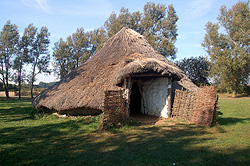Elstow in Prehistory
Elstow, as might be imagined, lying in a river valley so close to a major, navigable river, the Great Ouse, has a long history of considerable human activity. The Bedfordshire Historic Environment Record [HER] contains information on the county’s historic buildings and landscapes and summaries of each entry can now be found online as part of the Heritage Gateway website. The HER has references to a number of Bronze Age and Iron Age sites in Elstow but the earliest datable thing found in the area is a Neolithic axe made of greenstone found in 1971 [HER 1172]. It may have been found at Elstow Moors of just over the border in Eastcotts. A Bronze Age urn was found at an unknown date [HER 274].

A reconstruction of a Bronze Age round house at Flag Fen October 2011
Three sites associated with the Bronze Age (or the very late Neolithic) are known. Cropmarks east of Village Farm include two ring ditches which may be the remains of barrows or of round houses [HER 2421]. The area was examined in 1994 before the Bedford Southern Bypass was built and in 2002 before the building of the new lower school and flint scrapers, a core, some flakes, pottery, animal remains and grain were all found. The site also produced Iron Age, Dark Age and Medieval features and artefacts.
A group of cropmarks in the north-east of the parish are possibly more ring ditches [HER 1626]. A flint flake was found during examination ahead of the Bedford Southern Bypass and some Iron Age and Dark Age activity was also identified. Another site investigated ahead of the bypass, at Village Farm [HER 16082], produced a similar range of features and artefacts. Again, ring ditches were identified and flint flakes found as well as scrapers and an arrowhead which is probably late Neolithic. Flint tools continued to be used through the Bronze Age and even into the Iron Age as the raw material was plentiful and tools easier to make than bronze or iron tools.

A reconstruction of an Iron Age round house at Flag Fen October 2011
The Iron Age constituents of the site east of Village Farm [HER 2421] included a pit and post holes suggesting occupation, along with a bead, some animal bones, grain, a pot sherd and a quern for grinding grain. The site in the north-east of the parish [HER 1626] produced a rectangular enclosure typical of those found with Iron Age farmsteads and Village Farm [HER 16082] produced a hearth, three cremation burials, a building identifiable by post holes, a ditch, a pit, a loom weight and a pot.
A complex and extensive area of cropmarks west of Peartree Farm [HER 1624] seems to show trackways and other linear features. It was excavated in 1976 and a possible palisade and storage pits were found along with a loom weight, animal remains, a quern and a bodkin; unusually, remains of a musical instrument were also found. The site seems to have continued to be occupied into the Romano-British period.
North of Peartree Farm cropmarks suggest an Iron Age enclosure [HER 1625], replaced by a 2nd century AD Romano-British farm. Iron Age pottery was found. Soil marks east of Elstow Lodge [HER 8356] suggest small pits, gullies and a wall made of clunch stone. Some Iron Age pottery was found. Late Iron Age pottery was also found at a site extending into the Romano-British period east of Wilstead Road [HER 18247] as a result of field walking in 1999 during construction of a housing development.
An Iron Age boundary ditch has been identified west of the A6 and north of the brook in excavations prior to construction of the industrial estate at Progress Park [HER 18234]. Iron Age pottery was discovered.
Three sets of cropmarks in the parish have been identified tentatively as prehistoric. A linear cropmark between the A421 and B530 [HER 15792] suggests a trackway or road. It lies close to Iron Age and Romano-British sites west and north of Peartree Farm [HER 1624 and 1625]. Cropmarks east of Elstow Lodge suggest a north-south trackway and a possible rectangular enclosure [HER 16641]. Finally, cropmarks north of Medbury Farm extend along a brook and may indicate prehistoric trackways [HER 16642].